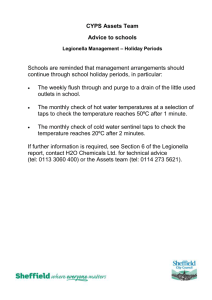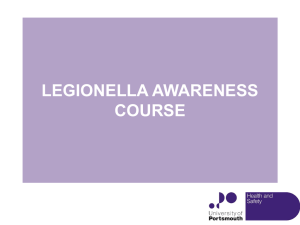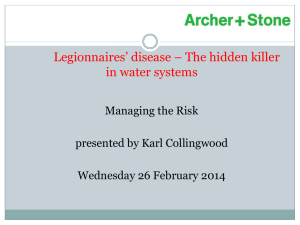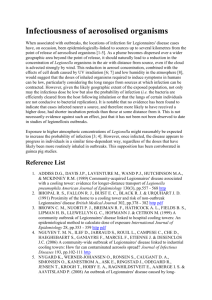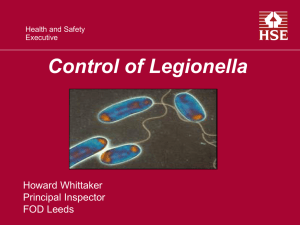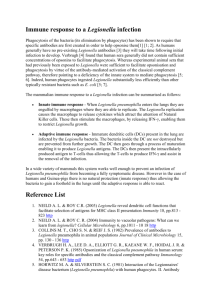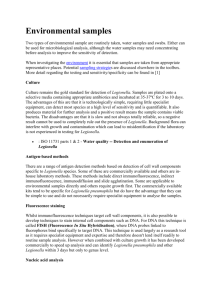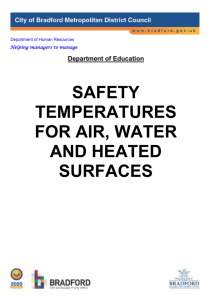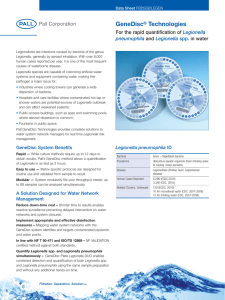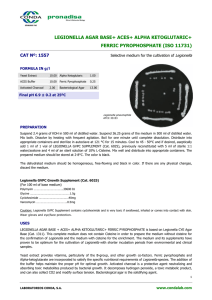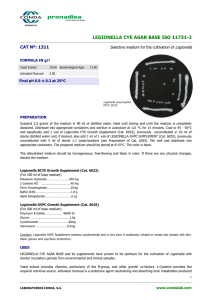background - TB-IPCP
advertisement
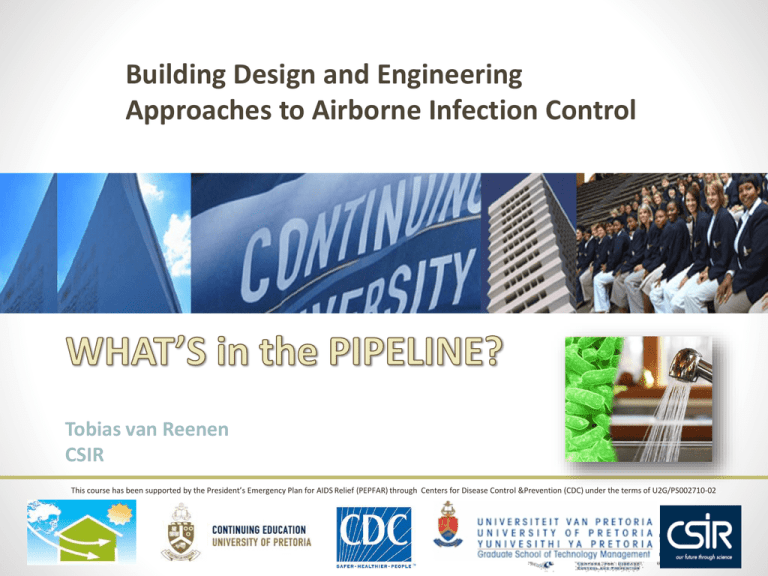
Building Design and Engineering Approaches to Airborne Infection Control Tobias van Reenen CSIR This course has been supported by the President’s Emergency Plan for AIDS Relief (PEPFAR) through Centers for Disease Control &Prevention (CDC) under the terms of U2G/PS002710-02 OVERVIEW • BACKGROUND • STANDARDS & LEGISLATION • DESIGN • MANAGEMENT 2 BACKGROUND BACKGROUND LEGIONELLA:Mesophilic Bacteria naturally occurring in low numbers in aquatic environments • Thrives in man-made water distribution and storage systems (20-50°C) • ~ Half of the species cause Legionellosis • Legionella Pneumophila is responsible for 90% of cases • Within endemic regions, about 4% to 5% of pneumonia are caused by L. pneumophila -Robert-Koch-Institut 3 BACKGROUND BACKGROUND LEGIONELLA PNEUMOPHILA:>70 °C At 66 °C At 60 °C At 55 °C 50 °C 35 to 46 °C 20 to 50 °C Below 20 °C : Disinfection range : Legionellae die within 2 minutes : They die within 32 minutes : They die within 5 to 6 hours : They can survive but do not multiply : Ideal growth range : Growth range : They can survive but are dormant 4 BACKGROUND BACKGROUND LEGIONELLA PNEUMOPHILA:- 35 to 46 °C 20 to 50 °C : Ideal growth range : Growth range 5 BACKGROUND BACKGROUND LEGIONELLA RISK ENVIRONMENTS • • • • • • • • • • Cooling towers and evaporative condensers Hot and Cold water systems especially showers Spa baths Water Features / Fountains Machinery Spray-Cooling Systems Water misting systems HVAC Systems Emergency Showers & Fire Hoses Sprinkler systems and hose reels Portable room humidifiers 6 BACKGROUND BACKGROUND Biofilm:a thin layer of microorganisms adhering to the surface of a structure, which may be organic or inorganic, together with the polymers that they secrete –http://medical-dictionary.thefreedictionary.com • Biofilm development can result in cyclical system contamination, complicating trouble-shooting 7 BACKGROUND BACKGROUND 4 EASY STEPS TO CONTRACTING LEGIONELLOSIS 1. 2. 3. 4. Contamination & Colonisation of Water Systems Growth & Proliferation Aerosolisation Inhalation Exposure (Duration x Susceptibility) 8 STANDARDS & LEGISLATION STANDARDS & LEGISLATION SOUTH AFRICA:• Occupational Health and Safety Act, 1993 Regulations For Hazardous Biological Agents – pg24 • SANS 11731: - Detection and enumeration of Legionella • Act No. 36, 1998 National Water Act • Act No. 108, 1997 Water Services Act • SANS 893 (1&2) Risk Management and Control of Legionella in Water Systems (Committee Draft for Comment) 9 DESIGN DESIGN • Biofilm colonises stagnant or low-flow water in piping. • Legionella risk increases with over-supply of Hand Wash Basins • Over-use of alcohol based hand sanitizers = stagnation in unused basins (Dead Legs) 10 WHO Supplementary Training Modules: Validation, Water, Air Handling Systems - Water for Pharmaceutical Use (Part 2): Water Purification Engineering 11 • A “dead leg” is a leg length >2x the diameter of the piping. DESIGN DESIGN • Avoid “dead legs” in distribution piping and fittings. • Point-of-use “RO filters” ? • Filters eradicate concentrate organisms • Point-of-use carbon filters? • Breading grounds for Bio-film • Aerosolizing/ Low flow faucets? • Increase inhalation risk • Pillar taps? • Open standing dead-legs • Automatic Faucets? • Internal bio-film • Maintenance burden http://www.shea-online.org/View/ArticleId/71/Electronic-Faucets-Unsafe-for-Use-inHigh-Risk-Patient-Hospital-Settings-Study-Shows-Automatic-Fauce.aspx DESIGN DESIGN 12 • Avoid warm water circulation or storage • Keep COLD loops <20°C • Keep HOT loops >55°C • Avoid storing too much water • Use of many smaller cisterns reduces stagnation • Avoid long pipe runs • Longer runs = • Greater heat gain in cold water systems • Greater heat loss in hot water systems • Cisterns should be insulated from heat sources DESIGN DESIGN 13 DESIGN DESIGN • Mixing devices should provide 55°C at upper limit of range • A geyser is the “gatekeeper” to your distribution system. • >55°C prevents colonisation of HW systems. • Geysers should be set to 60°C • Solar geysers can fail to maintain >45°C year round. 14 MANAGEMENT • Identify Risks • Hygiene risks • Safety risks (>55°C water) • Operational protocols • Thermostatic mixing • Define competency and responsibility (Hygiene & Safety) • Planners, • Designers & • Operators • Implement program MANAGEMENT 1. Risk Assessment and Management Plan 15 MANAGEMENT • Poor Water Supply Quality? • Dispersive Disinfection • Chlorination • Free Chlorine • Chloromines • Chlorine Dioxide • Silver & Copper ionisation • Thermal Pasteurisation • Site Disinfection • Ozone & UV • Not effective with downstream colonies MANAGEMENT 2. Disinfection 16 MANAGEMENT 3. Maintenance and Cleaning MANAGEMENT • Develop and Implement Cleaning program • Maintenance Policy • Record keeping 4. Training, Monitoring and Review • Training & Skills Matrix • Develop monitoring program • Updated asset register • Effective logbook • Engineering Change Control • Safety and Hygiene Risks 17 REFERENCES & FURTHER READING • http://www.ecosafe.co.za/legionella-background-information • Water Systems: HTM 04-01 The control of Legionella , hygiene, “safe” hot water, cold water and drinking water. Part A & B • ASHRAE White Paper : Position Paper on Legionellosis, 1995 • World Health Organization – Legionella and the Control of Legionellosis – 2007 – ISBN 92 4 156297 8 • SANS 893 (1&2) Risk Management and Control of Legionella in Water REFERENCES Systems (Committee Draft for Comment) 18
